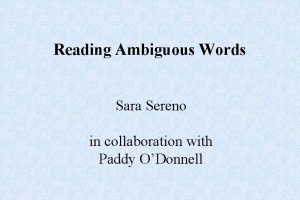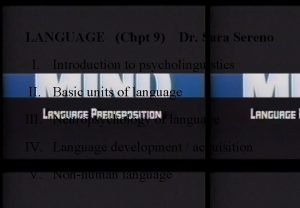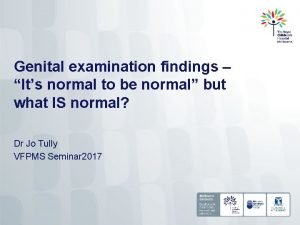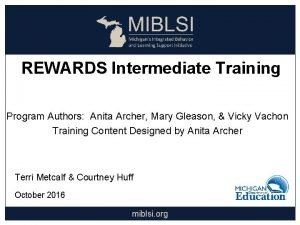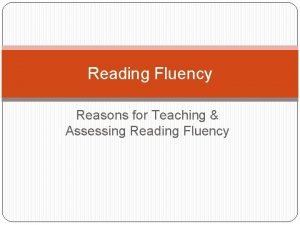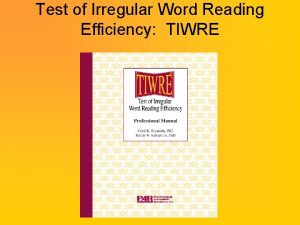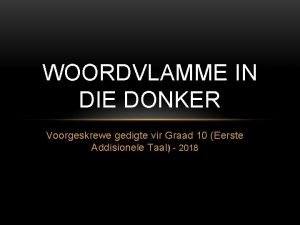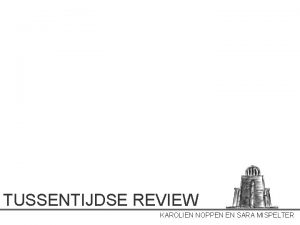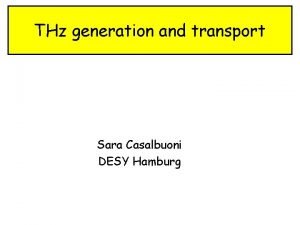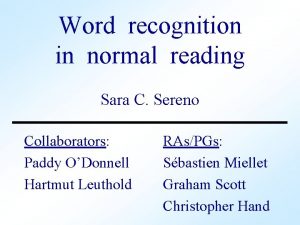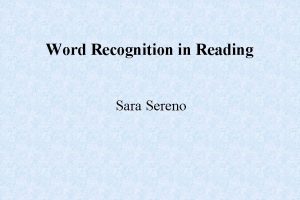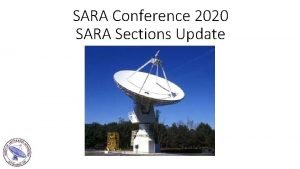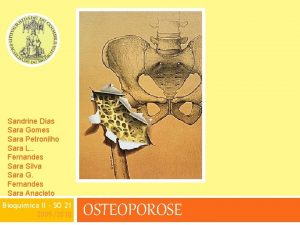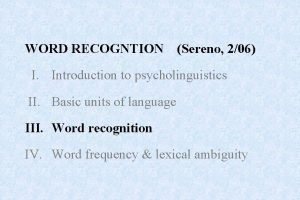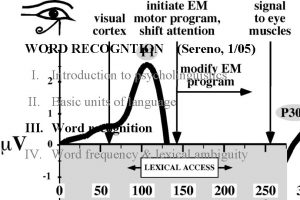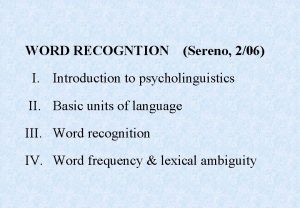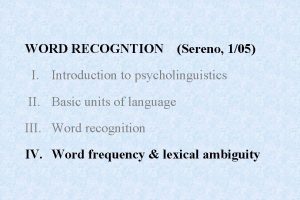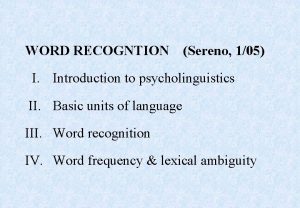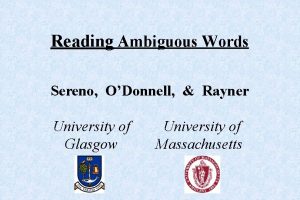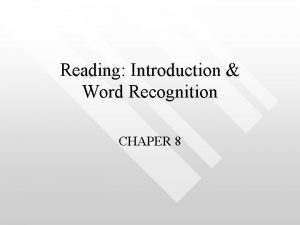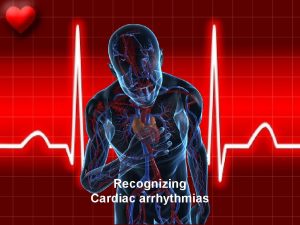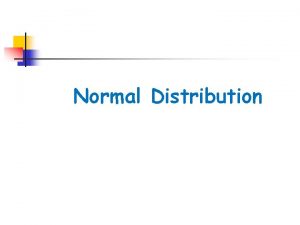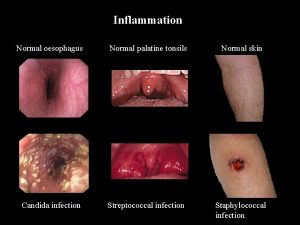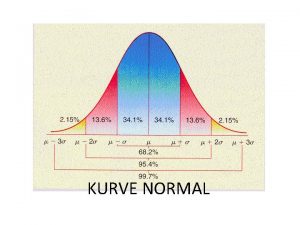Word recognition in normal reading Sara C Sereno

































- Slides: 33

Word recognition in normal reading Sara C. Sereno Collaborators: Paddy O’Donnell Hartmut Leuthold RAs/PGs: Sébastien Miellet Graham Scott Christopher Hand

Word Recognition • What factors affect word recognition? • How can word recognition processes be accurately measured? • How can effects be interpreted?

What factors affect word recognition? • Orthography of language – English vs. Hebrew or Japanese • Intraword (sublexical) variables – word-initial bi/tri-grams – spelling-to-sound regularity – neighborhood consistency – morphemes clown vs. dwarf hint vs. pint made vs. gave • prefix vs. pseudo-prefix remind vs. relish • compound vs. pseudo-compound cowboy vs. carpet

What factors affect word recognition? • Word (lexical) variables – word length – word frequency – Ao. A – expert vocabulary – syntactic class – ambiguity – concreteness/imageability – animacy – affective tone duke vs. fisherman student vs. steward rabbit vs. violin voxel open/closed-class; A, N, V bank (“money” “river”) tree vs. idea dog vs. cup love vs. farm vs. fire

What factors affect word recognition? • Extraword (supralexical) variables – Contextual predictability Neutral He bought a large plant for his garden. Biasing Terry went to the new gardening centre. He bought a large plant for his garden. – Syntactic complexity Trans. Mary took the book VERB Mary knew the book on the table. was good. the table. Intrans. Mary hoped the book on was good.

What factors affect word recognition? • Extraword (supralexical) variables – Discourse factors Focus The dog chased the cat today. The cat was chased by the dog today. What the dog chased was the cat today. It was the cat that was chased by the dog today. Elaborative inferences & anaphora stabbed … The mugger assaulted her with his weapon… weapon He threw the knife into the bushes and ran away.

What factors affect word recognition? • Language skill – beginning (novice) vs. skilled (expert) readers – normal vs. dyslexic vs. neuropsychological patient How can word recognition processes be accurately measured?

Measure Task Time Res. “electrical” imaging (EEG, MEG) single word presentation word-by-word reading ~80 – 500 ms (P 1, N 1, EPN, N 400) Eye movements in normal reading fixation time, location & sequence of EM’s ~250 ms RT naming, lexical decision categorization tasks; ± priming, masking, lateralized presentation ~500 – 800 ms “blood flow” imaging single word presentation (PET, f. MRI) seconds

Word-by-word reading: 200 ms per word presentation reading-like sentence word rate. This fast by of at is a

Word-by-word reading: 600 ms per word presentation sentence typically studies. word used ERP slow This rate by of at in is a

Normal Reading

* This is an approximation of normal reading in real time.

* This is an approximation of normal reading in real time.

* This is an approximation of normal reading in real time.

* This is an approximation of normal reading in real time.

* This is an approximation of normal reading in real time.

* This is an approximation of normal reading in real time.

* This is an approximation of normal reading in real time.

This is an approximation of normal reading * time. in real

This is an approximation of normal reading in* real time.

This is an approximation of normal reading * in real time.


The importance of making eye movements in normal reading Cond 1 Cond 2 There was a box of… Cond 1 Cond 2 She saw a cat in the… There was an enormous box of… She saw a cup in the… Perception of text influences how EMs made. AND Location/duration of EMs affect perception.

How can effects be interpreted? • Additive factors (1) Pick factors: stimulus quality, frequency, predictability (2) Independently manipulate 2 factors at once: Lo freq RT Hi freq – stim RT Lo freq RT + stim + – stim qual (3) Additive Interactive + sequential overlapping Hi freq + – context Context Stimulus Quality Frequency

How can effects be interpreted? • Modelling (1) Pick factors: oculomotor-related factors launch distance to word location of fixation within word number of fixations on word length word frequency contextual predictability language-related factors

How can effects be interpreted? • Modelling (1) Pick factors: oculomotor-related factors launch distance to word location of fixation within word number of fixations on word length word frequency contextual predictability language-related factors (2) Perform repeated measures multiple regression analysis to determine which factors account for most variance.

Factors orthography bi-/tri-grams regularity neighborhood morphology length frequency jargon word class ambiguity imagability animacy emotionality predictability syntactic prefs. focus inference anaphora skill Measures ERPs + word-by-word (slow) presentation Eye movements + normal reading EM-ERP co-registration? Approach Additive factors Repeated measures multiple regression

lexical human Distributed hierarchical visual processing in primates higher-level semantics syntax meanings word forms letters features

Conclusion Precisely delineating the time course of different components of word recognition allows us to: – determine when top-down effects modulate bottom-up processes; – inform neuroimaging localisation studies in order to construct a temporally realistic neural circuitry of normal reading.


Measurement EMs = best on-line measure of visual word recognition in the context of normal reading ERPs = best real-time measure of brain activity associated with the perceptual and cognitive processing of words

(Sereno & Rayner, Trends in Cognitive Sciences, 2003)

Sereno, Rayner, & Posner (1998). Neuro. Report. Sereno, Brewer, & O’Donnell (2003). Psych. Sci. (Sereno & Rayner, Trends in Cognitive Sciences, 2003)
 Sara sereno
Sara sereno While reading activities
While reading activities Anneo sereno
Anneo sereno Danza el sereno
Danza el sereno L'uomo selvaggio vive sereno e appagato
L'uomo selvaggio vive sereno e appagato L'uomo selvaggio vive sereno e appagato testo
L'uomo selvaggio vive sereno e appagato testo Language acquisition
Language acquisition Bem de manhã sereno surge o dia
Bem de manhã sereno surge o dia Ser sereno
Ser sereno Four part processing model for word recognition
Four part processing model for word recognition Four part processing model for word recognition
Four part processing model for word recognition Rapid word recognition chart
Rapid word recognition chart Hymen
Hymen What is normal incentive spirometer reading
What is normal incentive spirometer reading What is normal heart rate
What is normal heart rate St. louis
St. louis Aims of teaching reading
Aims of teaching reading Types of readers
Types of readers Guided reading vs shared reading
Guided reading vs shared reading Critical reading active
Critical reading active Real definition of extensive reading
Real definition of extensive reading What is intensive reading
What is intensive reading Style of reading
Style of reading Anita archer training
Anita archer training Woodcock johnson iv ordering
Woodcock johnson iv ordering Word reading accuracy
Word reading accuracy Tiwre
Tiwre Voorgeskrewe gedigte graad 10 2020
Voorgeskrewe gedigte graad 10 2020 A-teens 사라 룸홀트
A-teens 사라 룸홀트 Sara kimmich
Sara kimmich Sara mispelter
Sara mispelter Sara casalbuoni
Sara casalbuoni Sara calixto suicide girl
Sara calixto suicide girl Walgreen co v sara creek
Walgreen co v sara creek
